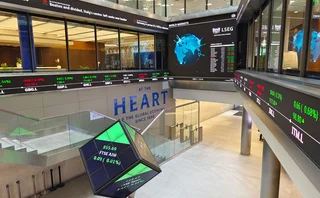
Innovation in execution: Morgan Stanley
Risk Awards 2020: Odd-lot bot handles almost half of bank’s credit trades

It was 2015, and Morgan Stanley’s credit desk had a problem. The number of small-ticket enquiries – or odd lots – was growing, and many of those requests were going unanswered. Missed responses meant missed revenue.
“Clients’ businesses were becoming increasingly electronified. The ticket sizes were getting a lot smaller. It was a lot more granular. Our need for a more effective way of responding to those tickets was very important, especially given the fact that the European credit market is incredibly competitive,” says Rehan Latif, head of Europe, the Middle East and Africa (Emea) credit sales and trading and global head of emerging market credit trading at Morgan Stanley.
Instead of hiring more traders to process the requests, the bank turned to a bot to price and execute odd-lot flow, trades in smaller and more irregular sizes than typical orders.
And it does the job well. The algorithm may initially have been introduced in 2017 to help the desk keep up with a rise in enquiries, but it has earned its place on the team, and now trades almost half of the credit desk’s tickets across investment-grade and high-yield globally.
Latif calls the machine “an incredible trader”.
Morgan Stanley is not the only bank to use algos to trade corporate credit, but over the last year, it has established itself as one of the leaders, with its algo propelling it into the top three from as low as the seventh spot in platform rankings by volume for investment-grade credit, says Latif.
As a result, the bank has been giving it more headroom – one-fifth of the available balance sheet for the US business and one-quarter for Europe. That’s a significant increase from over a year ago, and a testament to the algo’s performance, says Phil Allison, head of fixed income automated trading with the bank. Morgan Stanley has declined to disclose more precise measures on the record.
Today, the algo streams firm, two-way prices on over 12,000 US bonds and 4,500 European bonds, in addition to responding to all client requests for odd-lot pricing within its parameters.
The changes have not been lost on the buy side, where firms have been yearning for better electronic pricing and liquidity. A trader at a large asset manager calls the bank “one of the best algo-pricers in the fixed income market”.
“We’ve seen them noticeably pick up in terms of their ability to systematically respond to us and leverage that algo-pricer. It allows us to do our business much more efficiently now,” the trader adds.
My traders are becoming a lot more efficient. They’re focusing on the bigger tickets – the more interesting opportunities that they should be focusing on
Rehan Latif, Morgan Stanley
The firm prices are a key selling point in a market where many quotes are only indicative and can change once an investor wants to trade.
One trader at a European asset manager says Morgan Stanley’s executable prices are “very helpful: first, finding liquidity for smaller trades; and, secondly, finding out where it should price – seeing accurate pricing on your screen”.
“A lot of others … are not that accurate when updating prices. There is a lot of noise,” the trader says.
Morgan Stanley’s algo takes in pricing data from trade reporting venues to generate a mid-price, which it then uses to stream quotes to various trading platforms.
Whereas human traders may still be better at pricing large orders where data may be sparse, a computer can more efficiently digest small-ticket pricing data and previous quote requests, “assimilating all that into a model, and providing a better price in the smaller tickets than a human would be capable of – however many of them you had”, says Allison.
The bot is fully autonomous for trades in investment-grade credit up to roughly $5 million, and trades in high-yield up to roughly $1 million.
“We would generally be looking to run a reasonably well-hedged portfolio. But certainly within that, there will be a set of bonds the algo wants to hold because it thinks they are important to the portfolio in some shape or form. It could be as a hedge, or it could be because the algo explicitly thinks they’re trading cheap,” says Allison.

Capable of trading and managing risk without human intervention, the algo performs better during market-wide events – when volatility surged at the end of 2018, for example – than it does when news affects a specific credit, says Allison. But the algo is essentially never turned off during market hours, says the bank.
The unemotional nature of an algo often makes it a better trader than its human colleagues – particularly on news-filled days. It doesn’t get spooked, it never feels trapped and it doesn’t panic.
“When a name is moving up and down fairly rapidly, it’s able to capture the bid-offer much better than a human trader, who might be hit or lifted on a name and be wrong-sided, and then try to protect that position. The algo would square out its position and then trade with that bid-offer – and be able to capture it,” says Latif.
In additional to helping the bank gain market share, the algo has also allowed the trading desk to do more with its available resources.“My traders are becoming a lot more efficient. They’re focusing on the bigger tickets – the more interesting opportunities that they should be focusing on,” says Latif.
Only users who have a paid subscription or are part of a corporate subscription are able to print or copy content.
To access these options, along with all other subscription benefits, please contact info@risk.net or view our subscription options here: http://subscriptions.risk.net/subscribe
You are currently unable to print this content. Please contact info@risk.net to find out more.
You are currently unable to copy this content. Please contact info@risk.net to find out more.
Copyright Infopro Digital Limited. All rights reserved.
As outlined in our terms and conditions, https://www.infopro-digital.com/terms-and-conditions/subscriptions/ (point 2.4), printing is limited to a single copy.
If you would like to purchase additional rights please email info@risk.net
Copyright Infopro Digital Limited. All rights reserved.
You may share this content using our article tools. As outlined in our terms and conditions, https://www.infopro-digital.com/terms-and-conditions/subscriptions/ (clause 2.4), an Authorised User may only make one copy of the materials for their own personal use. You must also comply with the restrictions in clause 2.5.
If you would like to purchase additional rights please email info@risk.net
More on Awards
Clearing house of the year: LCH
Risk Awards 2025: LCH outshines rivals in its commitment to innovation and co-operation with clearing members
Best use of machine learning/AI: CompatibL
CompatibL’s groundbreaking use of LLMs for automated trade entry earned the Best use of machine learning/AI award at the 2025 Risk Markets Technology Awards, redefining speed and reliability in what-if analytics
Markets Technology Awards 2025 winners’ review
Vendors jockeying for position in this year’s MTAs, as banks and regulators take aim at counterparty blind spots
Equity derivatives house of the year: Bank of America
Risk Awards 2025: Bank gains plaudits – and profits – with enhanced product range, including new variants of short-vol structures and equity dispersion
Law firm of the year: Linklaters
Risk Awards 2025: Law firm’s work helped buttress markets for credit derivatives, clearing and digital assets
Derivatives house of the year: UBS
Risk Awards 2025: Mega-merger expected to add $1 billion to markets revenues, via 30 integration projects
Interest rate derivatives house of the year: JP Morgan
Risk Awards 2025: Steepener hedges and Spire novations helped clients navigate shifting rates regime
Currency derivatives house of the year: UBS
Risk Awards 2025: Access to wealth management client base helped Swiss bank to recycle volatility and provide accurate pricing for a range of FX structures







